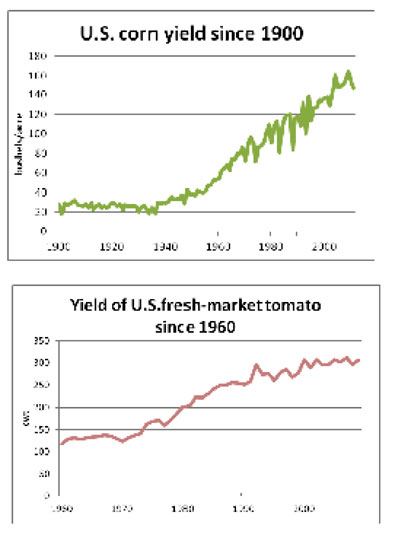Intensification Has Reduced Carbon Footprint Of U.S. Crop Production
LEXINGTON, KY.
In the scientific community,
it is widely accepted that
the global climate is changing,
and that human activities
are a principal cause of this.
Many human activities produce
“greenhouse gases”.
These transparent gases are
present at trace concentrations
in the Earth’s lower atmosphere. However,
they have the unique quality of trapping
heat there. This trapped heat is driving many
of the recent changes in the Earth’s climate, including
rising global temperatures. See the UK
Extension publication, Agriculture’s Contributions
to Climate Change: Not the “Top Dog”
(http://bit.ly/LrXozR) for more information on
sources of greenhouse gases in the U.S.
Policymakers worldwide are seeking ways to
reduce emissions of greenhouse gases, so that
we can reduce the disruptive impacts of climate
change on water supplies, food production,
human health, and extreme weather. Since carbon
dioxide is the most important greenhouse
gas, policymakers often speak of reducing our
“carbon footprint”.
Agricultural producers sometimes feel blamed
for climate change, especially in the media.
However, U.S. crop producers might be pleasantly
surprised to learn that recent research in
the world’s top science journals tells a different
story.
Recently, four prestigious research
papers emphasized how
crop intensification is an important
way to reduce the carbon footprint
of agriculture. A key point I take
away from these papers is rather
simple: For every acre of land
that we cultivate, we should
grow as much food as is reasonably
possible, with as little carbon
emission as possible.
U.S. producers excel at crop intensification
through agronomic/
horticultural improvement.
For example, astonishing increases
in grain yields have been achieved
in the U.S., yet yields continue to
rise (Fig. 1). Remarkable yield increases
have been achieved in horticultural
crops, as well (Fig. 2).

Our high-production agriculture
stands in contrast to the situation
in many developing countries,
where crop yields are quite a bit
lower. In such countries, the path
to producing more food often is to
bring more land under cultivation,
which can increase the carbon footprint
of food production by as
much as three times. Pound-forpound
of food produced, U.S. farmers
have significantly reduced the
carbon footprint of food production.
While U.S. agriculture has served
us very well over the years in providing
abundant, safe food, we can
do even more to reduce the carbon
footprint (Extension agents can
help with this). U.S. producers
would probably agree that the ultimate goal is
sustainable intensification: keeping the yield
gains made in intensification while continuing
to improve the sustainability of our agricultural
production systems. But it is also worth recognizing
that the success U.S. producers have
had in intensifying crop production has helped
to reduce climate change.
Bibliography
1. Foley et al, 2011. Solutions for a cultivated
planet. Nature, Volume 478, pages 337-342,
http://bit.ly/MdA5yo.
2. Grassini and Cassman, 2012. High-yield
maize with large net energy yield and small
global warming intensity, Proceedings of the
National Academy of Sciences, Volume 109.
Pages 1074-1079, http://bit.ly/KhTQCe.
3. Tilman et al, 2011. Global food demand
and the sustainable intensification of agriculture.
Proceedings of the National Academy of
Sciences, Volume 108, pages 20260-20264,
http://bit.ly/KiNC3L.
4. West et al, 2010. Trading carbon for food:
Global comparison of carbon stocks vs. crop
yields on agricultural land. Proceedings of the
National Academy of Sciences, Volume 107,
pages 19645–19648, http://bit.ly/KcjEEu.
Reviewed by Dr. Mike Crimmins (University of
Arizona), and Dr. David Van Sanford, Kevin J.
Lyons and Greg Henson (University of Kentucky).
Δ
DR. PAUL VINCELLI: Extension Professor and
Provost’s Distinguished Service Professor, University
of Kentucky